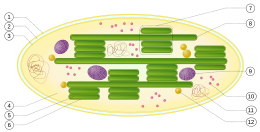
Back Chloroplas Afrikaans بلاستيدة خضراء Arabic Xloroplastlar Azerbaijani کولوروپلاست AZB Хларапласты Byelorussian Хлоропласт Bulgarian ক্লোরোপ্লাস্ট Bengali/Bangla Hloroplast BS Cloroplast Catalan Chloroplasts CEB


1. outer membrane
2. intermembrane space
3. inner membrane (1+2+3: envelope)
4. stroma (fluid)
5. thylakoid lumen (inside of thylakoid)
6. thylakoid membrane
7. grana (stacks of thylakoids)
8. thylakoid (lamella)
9. starch
10. ribosome
11. plastidial DNA
12. plastoglobule (drop of lipids)
A chloroplast is a small organelle inside the cells of plants and algae. They absorb light to make sugar in a process called photosynthesis. The sugar can be stored in the form of starch.
Chloroplasts contain the molecule chlorophyll, which absorbs sunlight for photosynthesis. In addition to chlorophyll, a chloroplast uses carbon dioxide (CO2) and water (H2O) to form sugar and gives off oxygen (O2).
Chlorophyll is what gives green plants their green colour. Chloroplasts also contain various yellow and orange pigments to assist in photon capture for photosynthesis.
